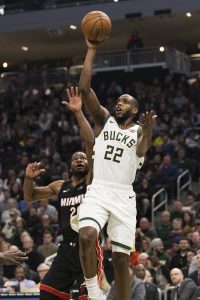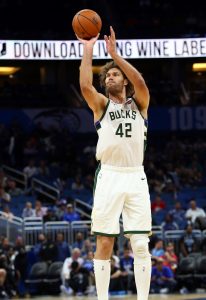Hoops Rumors is breaking down the 2019 offseason for all 30 NBA teams, revisiting the summer’s free agent signings, trades, draft picks, departures, and more. We’ll evaluate each team’s moves from the last several months and look ahead to what the 2019/20 season holds for all 30 franchises. Today, we’re focusing on the Milwaukee Bucks.
Signings:
- Standard contracts:
 Khris Middleton: Five years, $177.5MM. Fifth-year player option. Re-signed using Bird rights.
Khris Middleton: Five years, $177.5MM. Fifth-year player option. Re-signed using Bird rights.- Brook Lopez: Four years, $52MM. Re-signed using cap room.
- George Hill: Three years, $28.77MM. Third year partially guaranteed ($1.28MM). Re-signed using cap room.
- Robin Lopez: Two years, $9.77MM. Second-year player option. Signed using room exception.
- Wesley Matthews: Two years, minimum salary. Second-year player option. Signed using minimum salary exception.
- Thanasis Antetokounmpo: Two years, minimum salary. Signed using minimum salary exception.
- Dragan Bender: Two years, minimum salary. Partially guaranteed ($300K). Signed using minimum salary exception.
- Note: Partial guarantee increased to $600K on opening night.
- Kyle Korver: One year, minimum salary. Signed using minimum salary exception.
- Two-way contracts:
- Non-guaranteed camp contracts:
- Jaylen Adams: One year, minimum salary (Waived).
- Jemerrio Jones: One year, minimum salary (Waived).
- Trevor Lacey: One year, minimum salary (Waived).
- Luke Maye: One year, minimum salary (Waived).
- Rayjon Tucker: One year, minimum salary (Waived).
Trades:
- Acquired Jon Leuer from the Pistons in exchange for Tony Snell and the draft rights to Kevin Porter Jr. (No. 30 pick).
- Note: Leuer was later waived.
- Acquired the Pacers’ 2020 first-round pick (top-14 protected), the Pacers’ 2021 second-round pick, and the Pacers’ 2025 second-round pick from the Pacers in exchange for Malcolm Brogdon (sign-and-trade).
- Note: The Pacers’ traded 2021 second-round pick will convey one year after the Pacers’ 2020 second-round pick (45-60 protected through 2022; unprotected in 2023) conveys.
Draft picks:
- None
Departing players:
- Malcolm Brogdon
- Bonzie Colson (two-way)
- Tim Frazier
- Pau Gasol
- Nikola Mirotic
- Tony Snell
Other offseason news:
- Signed general manager Jon Horst to contract extension.
- Lost assistant coach Taylor Jenkins to Grizzlies.
- Hired Chad Forcier as assistant coach.
- Fined $50K by NBA for publicly vowing to offer Giannis Antetokounmpo super-max deal in 2020.
- Exercised 2020/21 rookie scale team options on D.J. Wilson, Donte DiVincenzo.
Salary cap situation:
- Used cap space; now over the cap.
- Carrying approximately $129.63MM in salary.
- No cap exceptions available.
Story of the summer:
The Bucks were one of the NBA’s most improved teams in 2018/19, winning a league-high 60 regular season games and 10 of their first 11 playoff contests before losing four straight to the eventual champion Raptors.
While that four-game losing streak to end the season – the first time the Bucks had lost more than two in a row all year – was discouraging, it was hard not to focus on the positives as the offseason began. Kawhi Leonard‘s looming departure meant that the Bucks would probably have the upper hand in their next matchup with the Raptors. It also meant Milwaukee would have the Eastern Conference’s best player in Giannis Antetokounmpo, last season’s MVP. Now it was just a matter of bringing back his supporting cast.
That last part would be a challenge. Of the seven non-Giannis Bucks who played the most minutes in the postseason, only two were under contract beyond 2018/19, and one of those two was Eric Bledsoe, who played poorly during the club’s postseason series vs. Toronto.
While Antetokounmpo was the player most responsible for the Bucks’ 60-win season, he didn’t do it by himself. An offseason exodus of talent would hurt Milwaukee’s chances of making another deep playoff run and might negatively impact the organization’s chances of keeping the reigning MVP around beyond his current contract.
So general manager Jon Horst and the Bucks’ front office got creative as they looked to retain as much talent as possible. They dipped below the cap to offer Brook Lopez a bigger contract than his Non-Bird rights would allow, while retaining Khris Middleton‘s full Bird rights in order to eventually go back over the cap when they re-signed him. George Hill, meanwhile, was waived and then re-signed to a longer, more cap-friendly deal.
Milwaukee didn’t retain everyone though. Nikola Mirotic, who opted to return to his home country to play for Barcelona, almost certainly would’ve landed with a new team even if he had remained in the NBA. Malcolm Brogdon, on the other hand, looked like a strong candidate to be brought back by the Bucks, but they ultimately sent him to Indiana in a sign-and-trade in exchange for multiple draft picks, including a first-rounder.
At times last season – particularly after he returned in the playoffs – Brogdon looked like the Bucks’ second-best player, but a handful of factors contributed to his exit. Among the most notable factors? Bledsoe’s $70MM extension, signed in March, and an apparent reluctance by Bucks ownership to go into tax territory.
There were no real cap limitations stopping Milwaukee from re-signing Brogdon with or without Bledsoe’s deal on the books, but if the team was looking to avoid substantial tax penalties, it essentially had to keep one point guard or the other. It’ll be fascinating to see whether choosing Bledsoe in the winter before he struggled in the postseason for a second consecutive spring will come back to haunt the Bucks.
Key offseason losses:
Brogdon’s ability to handle the ball, make shots, and play strong perimeter defense made him a valuable asset for the Bucks. His .505/.426/.928 shooting line was one of the best in the NBA in 2018/19, and despite playing plenty of point guard, he didn’t dominate the ball at all, often deferring to Antetokounmpo and Bledsoe.
The Bucks haven’t said a whole lot about Brogdon’s departure, so it’s not clear just how significant a factor the tax concerns were in the decision to let him go. A June report suggested that the team had a “walk-away” number it was unwilling to exceed on Brogdon, so if the Pacers’ offer was higher than that number, Milwaukee did well to get some draft picks out of the situation.
It’s also worth noting that Brogdon was red-flagged prior to the 2016 draft due to foot surgery, and once again battled foot issues in ’18/19. If the Bucks were worried about those foot issues continuing to re-surface in future seasons, that could be another reason why the team was unwilling to match the Pacers’ four-year, $85MM offer.
Mirotic was the other key loss for the Bucks, though he was another player – like Bledsoe – who stumbled in the playoffs, making just 28.9% of his postseason three-point attempts, including 6-of-31 (19.4%) vs. Toronto. Mirotic’s floor-spacing abilities as a big man helped open up Milwaukee’s offense and create driving lanes for Antetokounmpo and others, but when he wasn’t making those shots, he was essentially unplayable — he didn’t log a single minute in Game 6 vs. the Raptors, the final game of the Bucks’ season.
Tony Snell had been a starter for Milwaukee during the previous two seasons, but came off the bench in 2018/19 and saw his role cut back — his 17.6 minutes per game represented his lowest mark since his rookie year. He remained a solid contributor, knocking down 39.7% of his three-pointers, but it became untenable for the team to carry his multiyear contract and his eight-figure annual salary as core players became more expensive. He was moved to Detroit in a salary-dump deal.
Tim Frazier and Pau Gasol also departed this summer, though neither loss should have a major impact on the Bucks’ rotation. Frazier played extremely limited minutes in the playoffs, while ankle and foot injuries limited Gasol to just three games in total during his brief stint in Milwaukee.
Key offseason additions:
Rather than signing another point guard to provide depth behind Bledsoe and Hill, the Bucks tabbed Wesley Matthews to help fill the void created by Brogdon’s departure. At age 33, Matthews isn’t the same sort of high-quality three-and-D player he once was, but he can still provide enough value at both ends of the court to easily outperform his minimum-salary contract. In 69 games for three teams last season, he knocked down 37.2% of 5.8 three-point attempts per game.
 With Mirotic and Gasol on the way out, the Bucks replenished their frontcourt depth by signing Robin Lopez and Dragan Bender in free agency. The former signing pairs the Lopez twins up front, and while I doubt we’ll see them playing alongside one another too often, Robin brings a much different skill set than Brook does.
With Mirotic and Gasol on the way out, the Bucks replenished their frontcourt depth by signing Robin Lopez and Dragan Bender in free agency. The former signing pairs the Lopez twins up front, and while I doubt we’ll see them playing alongside one another too often, Robin brings a much different skill set than Brook does.
Brook is a talented low-post scorer who added a reliable three-point shot to his game in recent years and helped protect the rim for the Bucks in 2018/19. Robin isn’t as dynamic an offensive player and probably won’t give the team much from beyond the arc, despite his uptick in three-point attempts in the early going this season. However, he’s a fundamentally sound, high-IQ contributor who plays excellent team defense and has mastered the art of the box-out. He’ll be an important part of Milwaukee’s rotation when the club goes up against top Eastern Conference centers like Joel Embiid and Marc Gasol.
Bender, on the other hand, is a developmental piece who probably won’t play much unless injuries force the Bucks’ hand. The same can be said of Thanasis Antetokounmpo, one of the offseason’s most improbable recipients of a multiyear guaranteed contract. It’s probably safe to say he wouldn’t be on Milwaukee’s roster if his last name were Smith.
The other new addition to the Bucks’ rotation this season is Kyle Korver, who signed a minimum-salary contract after being bought out by Phoenix. Even at age 38, Korver looks capable of making 40% of his three-pointers in his sleep. His marksmanship could come in handy for Milwaukee, though he’ll have to prove he’s not a liability on defense in order to hang onto his spot in the rotation all season and into the playoffs.
Outlook for 2019/20:
Bucks players and coaches probably lost some sleep during the summer thinking about the overtime period of Game 3 of the Eastern Conference Finals. If the Bucks had won that game, it would’ve given them a 3-0 lead over Toronto and perhaps put them in the driver’s seat to win a championship.
This year’s Bucks team might not be quite as talented as last year’s squad, but it also might not need to be. Milwaukee’s top competitors each lost key players, with Leonard leaving Toronto and Jimmy Butler leaving Philadelphia. Both teams still have extremely talented rosters, and clubs like the Celtics and Heat are threatening to move into the top tier of Eastern Conference contenders, but there’s a reason oddsmakers’ forecasts during the preseason viewed the Bucks as the team to beat.
This season could go a long way toward convincing Giannis one way or the other whether he wants a long-term future in Milwaukee, so the Bucks will do all they can this year to push for a title. Anything less than a return trip to the Eastern Finals will be considered a disappointment.
Salary information from Basketball Insiders was used in the creation of this post. Photos courtesy of USA Today Sports Images.